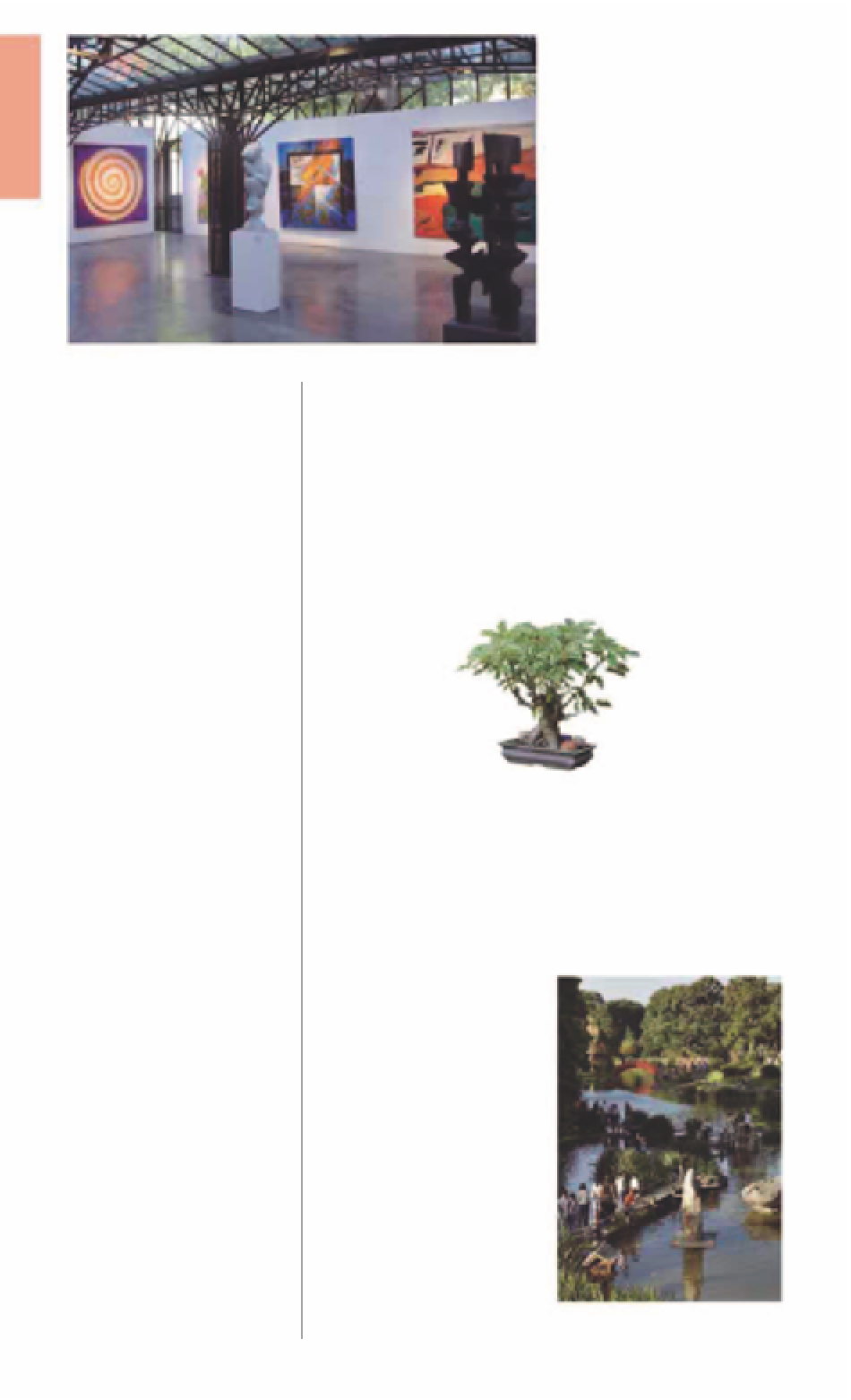Travel Reference
In-Depth Information
including the academic
naturalism of Sívori and the
Impressionist landscapes of
Ramón Silva and Walter de
Navazio. Works span the Post-
Impressionist and Cubist periods,
all the way to Surrealism, Pop
Art, and Hyperrealism. The
museum moved to its current
picturesque home, not far from
the Rosedal at Parque 3 de
Febrero, in 1995, and now
has a small shop, sculpture
garden, and café.
Contemporary art displays at the Museo de Artes Plásticas Eduardo Sívori
3
Jardín Japonés
Ave Casares & Ave Berro.
City Map
5
F3.
Te l
(011) 4804-4922.
@
10, 34, 36.
Open
10am-6pm daily.
&
8
11am
Sat & Sun (Spanish only).
0
7
∑
jardinjapones.org.ar
1
Parque 3
de Febrero
Ave Adolfo Berro.
City Map
5 E2.
£
Palermo, Lisando de la Torre.
Palermo, Plaza Italia.
@
10, 34, 36, 37,
67, 130.
The capital's largest and most
popular park, Parque 3 de
Febrero is also known as the
Bosques de Palermo (Palermo
Woods). In the 19th century, the
land was owned by Argentinian
dictator Juan Manuel de Rosas.
Following his defeat by General
Urquiza in the Battle of Caseros
on February 3, 1852, all his
land was confiscated and ear-
marked for public use. In 1874,
the site was converted into a
park styled after Paris's Bois de
Boulogne and London's Hyde
Park and named Parque 3 de
Febrero, after the Battle of
Caseros. French landscape
architect Charles Thays was
responsible for the design
of the park, as well as that of
the nearby Jardín Botánico. It
was inaugurated in 1875 by
President Nicolás Avellaneda.
Apart from beautifully tended
lawns, the park contains a
variety of attractions that
include a spherical planetarium
and the Velódromo Municipal,
which was opened in 1951 for
the Pan-American Games. Most
popular is the Rosedal, a rose
garden designed by landscape
architect Benito Carrasco, which
features about 12,000 rose
bushes, a boating lake with
pedalos and rowing boats, a
wooden bridge, and pergola.
The space also has a Poet's
Garden, with busts of famous
poets, among them Jorge Luis
Borges, Federico García Lorca,
and Shakespeare.
Among the monuments in
the park are the Monumento a
los Españoles, erected as part
of the centenary celebrations
of the Revolución de Mayo in
1810
(see p53)
; Auguste Rodin's
monument to Sarmiento; and a
monument to General Urquiza.
Over the weekends
the sprawling park
gets plenty of
joggers, family
picnickers, walkers,
and bicyclists.
These peaceful and carefully
maintained gardens were
created in 1967 as a gift to the
city by its sizable Japanese
community. They feature clear
man-made lakes and
islands. These are
crisscrossed by
pretty red wooden
bridges, such as the
curved Puente de la
Buena Ventura, leading
to the Isla de los
Dioses (Island of the
Gods). A wealth of
flora flourishes here,
much of which was imported
from Japan, including sakura,
ginkgo, and black pines. There
are also giant koi carp in the
lake, and ducks roaming the
gardens. The pagoda houses a
2
Museo de
Artes Plásticas
Eduardo Sívori
Ave Infanta Isabel 555.
City Map
5
E2.
Te l
(011) 4774-9452.
@
10, 34,
36, 37, 67, 130.
Open
noon−8pm
Tue−Fri, 10am−8pm Sat & Sun.
7
&
free Sat & Wed.
8
4pm
& 5pm Sat (English).
-
=
∑
museosivori.org.ar
Bonsai plant at Jardín
Japonés
The Museo de Artes Plásticas
Eduardo Sívori houses a diverse
and significant collection of
over 4,000 pieces of art, among
them drawings, paintings,
sculptures, and tapestries,
dating from the 19th century
to the present day. The
museum was founded in 1938
as the Museo Municipal de
Bellas Artes, Artes Aplicadas y
Anexo de Artes Comparadas,
but was later renamed for the
famous Buenos Aires artist
Eduardo Sívori (1847−1918).
The museum covers a huge
range of styles and media,
Koi Pond, one of the man-made lakes at
the Jardín Japonés
For hotels and restaurants see pp278-83 and pp288-99





































